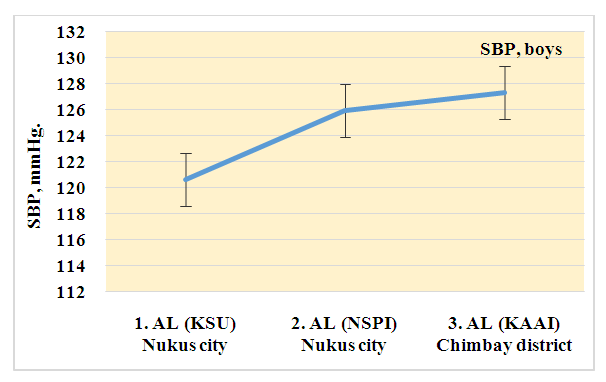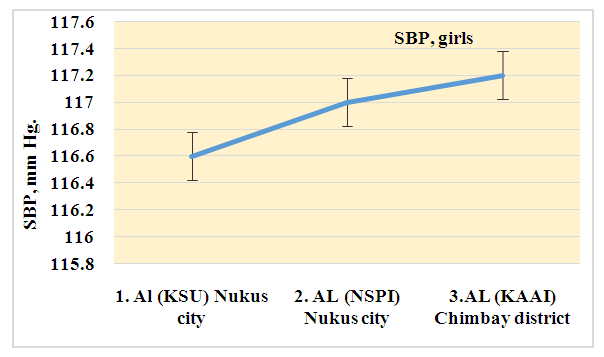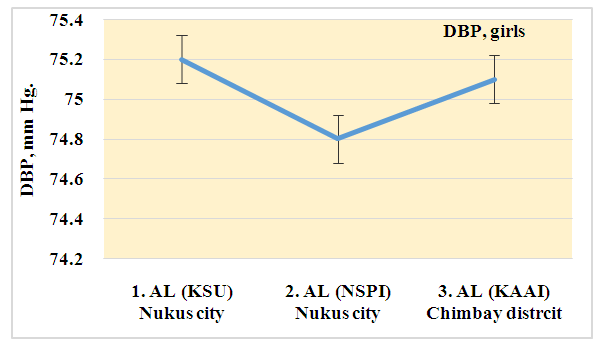-
Paper Information
- Paper Submission
-
Journal Information
- About This Journal
- Editorial Board
- Current Issue
- Archive
- Author Guidelines
- Contact Us
International Journal of Genetic Engineering
p-ISSN: 2167-7239 e-ISSN: 2167-7220
2024; 12(3): 28-33
doi:10.5923/j.ijge.20241203.02
Received: Mar. 28, 2024; Accepted: Apr. 16, 2024; Published: Apr. 25, 2024

Features of the Functioning of the Regulatory Systems of the Body of Lyceum Students in the Conditions of the Republic of Karakalpakstan
Mambetullaeva Svetlana Myrzamuratovna1, Ramazanov Medetbay Baxitbayevich2
1Doctor of Biological Sciences, Professor, Karakalpak Research Institute of Natural Sciences
2Acting Associate Professor, Nukus Branch of the Uzbek State University Physical Culture and Sports, Nukus, Uzbekistan
Correspondence to: Ramazanov Medetbay Baxitbayevich, Acting Associate Professor, Nukus Branch of the Uzbek State University Physical Culture and Sports, Nukus, Uzbekistan.
| Email: |  |
Copyright © 2024 The Author(s). Published by Scientific & Academic Publishing.
This work is licensed under the Creative Commons Attribution International License (CC BY).
http://creativecommons.org/licenses/by/4.0/

The article discusses the influence of environmental factors on the health of students at academic lyceums in the Republic of Karakalpakstan. According to the research, data on the average height and weight of students of academic lyceums of the Republic of Karakalpakstan were analyzed. The results obtained can be used in the development of regional anthropometric standards, as well as for optimizing the educational process in lyceums and technical schools, as well as in developing strategies to prevent pathological conditions that may arise in the body of students.
Keywords: Health preservation, Environmental factors, Physical education, Approaches, Monitoring, Environment, Adaptation
Cite this paper: Mambetullaeva Svetlana Myrzamuratovna, Ramazanov Medetbay Baxitbayevich, Features of the Functioning of the Regulatory Systems of the Body of Lyceum Students in the Conditions of the Republic of Karakalpakstan, International Journal of Genetic Engineering, Vol. 12 No. 3, 2024, pp. 28-33. doi: 10.5923/j.ijge.20241203.02.
1. Introduction
- For the formation of a comprehensively developed, harmonious personality, the ability of a developing organism to adapt to external factors is extremely important. Therefore, the problem of adaptation of students’ bodies to various stress factors continues to occupy one of the leading places in theoretical and practical human ecology [1-3]. Man is a structural unit of the ecosystem of planet earth. he experiences the influence of a changing environment, which increases from year to year. Negative factors of anthropogenic impact are not only detrimental to ecosystems, but also contribute to a decrease in health reserves at the individual, family and population levels, an increase in the degree of psychophysiological and genetic stress, an increase in specific pathology and the emergence of new forms of environmental diseases, and in some areas - the development of depopulation phenomena.Environmental pollution has become global in recent years. the situation is aggravated by the long-term practice of ignoring environmental protection measures. With industrial emissions, hundreds of thousands of tons of substances harmful to nature enter the environment every year. The level of natural pollution is considered as background, which changes little over time. Depending on the type, pollution can be biological, physical and chemical, in scale - global, regional, local.The problem of adaptation of the youth population is of particular relevance at present with the ongoing introduction of innovative technologies into the learning process against the backdrop of declining physical activity of schoolchildren of all ages. The success of adaptive capabilities is determined by the functional state of the body’s regulatory systems [1,2,3]. In recent years, there has been an active search and determination of objective and informative indicators of early changes in the body caused by the influence of unfavorable environmental factors.The theoretical basis for diagnosing environmental disorders is the concept of adaptive response (adaptation to changing conditions of existence) of the organism, aimed at maintaining homeostasis in changing environmental conditions.Let us emphasize that all major theories of human adaptation are applicable to ecological adaptation. Thus, one of the most important manifestations of life activity at all levels of its organization is considered anticipation according to A.D. Speransky. Speransky’s research was of pioneering importance for the study of innate anticipation, which prevents stereotypical changes undesirable for the body after a primary pathogenic effect. It has been proven that the mechanisms of “natural” recovery are activated from the moment the pathogenic factor appears and act proactively throughout the entire course of the disease. [8.32-38]Therefore, treatment and prevention of diseases should be aimed not only at neutralizing the pathogenic stimulus (which is not always possible), but also at activating genetically determined mechanisms of natural recovery.The physical development of a person is understood as a complex of functional and morphological properties of the organism, which ultimately determines the reserve of its physical strength. Physical development is influenced by many endogenous and exogenous factors, which determines the frequent use of physical development assessments as integral indicators to characterize health status. indicators of physical development, as a rule, are considered positive signs of health.
2. Methods
- In ontogenesis, physical development is important for assessing the state of health of the human body, especially school-age children and adolescents, preventing pathological conditions with varying probability and taking measures for their normal physiological and intellectual development [4.12-135].According to research, it has been established that the average height of boys studying in academic lyceums of the Republic of Karakalpakstan is 166 ± 2.41 (for 15 years old) and 172.5±2.10 (for 16 years old) (Fig.1)
 | Figure 1. Body growth indicators for boys-students of lyceums in the Republic of Karakalpakstan |
 | Figure 2. Body weight indicators of boys-students of lyceums in the Republic of Karakalpakstan |
 | Figure 3. Body growth indicators for girls - lyceum students in the Republic of Karakalpakstan |
 | Figure 4. Body weight indicators of girls - lyceum students in the Republic of Karakalpakstan |
3. Results
- The results obtained generally correspond to the data of existing literature [5.12-14].It is currently noted that the modern education system at school is constantly increasing the volume and speed of information flow based on new pedagogical technologies into the educational process and, in turn, causes a specific state of intellectual tension in the body of students. On the other hand, the period of schooling is the optimal period for the formation of healthy physical development of the body of children and adolescents, and monitoring the level of physical development of this contingent is of important theoretical and practical importance [6.141].The results obtained can be used in the development of regional anthropometric standards, as well as in optimizing the educational process in lyceums and technical schools, as well as in developing strategies for the prevention of pathological conditions that may arise in the body of students.When assessing the level of functioning of the body, indicators of the cardiovascular system are important, since the level of metabolism depends on the nature of the blood supply. We can say that indicators of the functional state of the cardiovascular system reflect the “cost of adaptation” [9].One of the main regulated parameters of the circulatory system is blood pressure. Changes in blood pressure levels are often found in pediatric practice: both in the direction of increasing it (arterial hypertension) and decreasing it (arterial hypotension), especially during puberty. The importance of blood pressure for the life of the body is determined by the special role of mechanical energy for the functions of blood as a universal mediator in the metabolism and energy in the body, as well as between the body and the environment. Discrete portions of mechanical energy generated by the heart only during systole are converted in blood pressure into a stable one, acting during diastole of the heart, a source of energy supply for the transport function of the blood, diffusion of gases and filtration processes in the capillary bed, ensuring the continuity of metabolism and energy in the body and mutual regulation of the functions of various organs and systems by humoral factors carried in the circulating blood.Blood pressure measurement is one of the most widely used methods in physiology, because firstly, detecting changes in blood pressure is important in the diagnosis of many diseases of the circulatory system and various pathological conditions; secondly, a pronounced increase and decrease in blood pressure in itself can be the cause of severe hemodynamic disorders. According to research by many specialists an indicator such as mean arterial pressure is indicated. mean arterial pressure has no pulse fluctuations and can change only in the interval of several cardiac cycles, being the most stable indicator of blood energy, the values of which are determined almost exclusively by the values of the minute volume of blood supply and the total peripheral resistance to blood flow. The level of blood pressure in children is not only genetically determined, but largely depends on the stage of puberty, body length and weight, the degree of development of skeletal muscles and cardiac muscles, the nature of physical activity, the lability of the autonomic nervous system, the psychological climate in the family and school, and from other factors of the internal and external environment [7.179-183].
4. Discussion
- The health status of lyceum students living in the central zone - the city of Nukus - is associated with a slightly increased influence of the accelerated movement of air masses throughout the year (13.8%) in the presence of a significant level of vegetation cover (14.1%). In this regard, the least impact on the formation of the health of adolescents living in this zone is exerted by the quality of vegetation cover, which in this zone is least susceptible to the influence of the anthropogenic environment due to the current decrease in economic activity of the population.A decrease in external respiration function was revealed in adolescent lyceum students from technogenically polluted areas, which was more pronounced under conditions of chemical pollution of atmospheric air. Indicators of the functional state of the cardiovascular system (CVS) are presented in Table 1.
|
 | Figure 5. SBP indicators for boys studying in academic lyceums of the Republic of Karakalpakstan |
 | Figure 6. DBP indicators for boys studying in academic lyceums of the Republic of Karakalpakstan |
 | Figure 7. Heart rate indicators for boys studying in academic lyceums of the Republic of Karakalpakstan |
 | Figure 8. SBP indicators for girls studying in academic lyceums of the Republic of Karakalpakstan |
 | Figure 9. DBP indicators for girls studying in academic lyceums of the Republic of Karakalpakstan |
 | Figure 10. Heart rate indicators for girls studying in academic lyceums of the Republic of Karakalpakstan |
5. Conclusions
- Taking into account the above, it can be stated that disturbances in the ecological balance of the natural environment in the southern Aral Sea region largely determine the state of morbidity among the population. Analysis of the forms of diseases and their relationship with negative environmental factors showed a persistent tendency to increase the group of diseases directly related to excessive pollution of water, soil, air, etc.The assessment of the influence of factor loads of environmental parameters of the habitat on the health of lyceum students living in various regions of Karakalpakstan is determined by the following levels of impact on the body: the highest level is the level of atmospheric air pollution (32.4%). The next factors in terms of influence are transport loads (5.8%). geoenvironment parameters bear an almost equal load and amount to 2.8%. in one of the last places - the characteristics of chemical pollution and unfavorable physical factors in populated areas - 2.1%. The health status of lyceum students living in the central zone - the city of Nukus - is associated with a slightly increased influence of the accelerated movement of air masses throughout the year (13.8%) in the presence of a significant level of vegetation cover (14.1%). in this regard, the least impact on the formation of the health of adolescents living in this zone is exerted by the quality of vegetation cover, which in this zone is least susceptible to the influence of the anthropogenic environment due to the current decrease in economic activity of the population.Thus, the health status of children and their physical development, i.e. biological and physiological processes that determine the growth and development of children, their functional state of the circulatory system, to a greater extent, directly or indirectly related not only to environmental factors, but also to social and hygienic living conditions. Information and facts indicating the impact of social risk, i.e. social, hygienic and living conditions on the physical development and health of children, serve as a scientific basis for planning and carrying out health-improving activities.
 Abstract
Abstract Reference
Reference Full-Text PDF
Full-Text PDF Full-text HTML
Full-text HTML